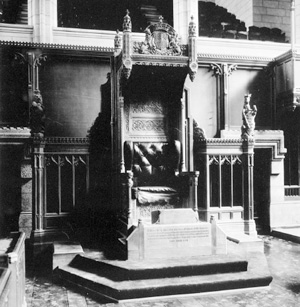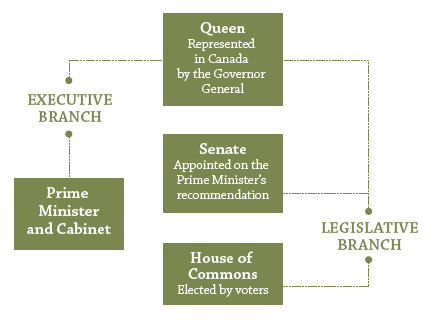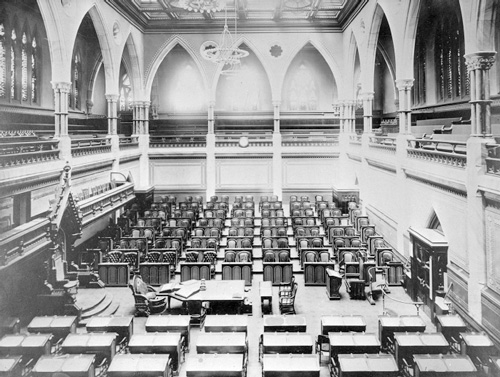Work in the House of Commons
The House of Commons follows a parliamentary calendar
with a schedule of sittings and adjournments running
from mid-September through late June. The fiscal year
2008-2009 marked the end of the 39th Parliament and the
beginning of the 40th Parliament.
In 2008, the House continued its work as part of the
second session of the 39th Parliament, until rising for
the summer break on June 20, 2008. On September 7, 2008,
before the House resumed for the fall sitting, the Prime
Minister asked the Governor General to dissolve
Parliament and call an election. Following the general
election on October 14, 2008, the 40th Parliament was
summoned to meet on November 18, 2009.
The House of Commons in Session
Meetings of the House of Commons are known as sittings
and follow a prescribed format. They are overseen by the
Speaker, who is responsible for managing debate and
preserving order in accordance with the written rules
(Standing Orders) and practices of the House. The Speaker
is an elected Member of Parliament who, in a secret
ballot, is chosen to be Speaker by the other Members.
At the beginning of the 40th Parliament, the Hon. Peter
Milliken was elected Speaker for the fourth consecutive
time, a record. Mr. Milliken is a member of the Official
Opposition but, as Speaker, he does not attend caucus
meetings.
In addition to presiding over the Chamber, the Speaker is
Chair of the Board of Internal Economy, which oversees
the administration of the House. He is also the
spokesperson and formal representative of the House when
conducting business outside the House of Commons.
The Speaker is assisted by three deputies selected from
among the Members: the Deputy Speaker and Chair of
Committees of the Whole, the Deputy Chair of Committees
of the Whole, and the Assistant Deputy Chair of
Committees of the Whole. In those positions during the
39th Parliament, respectively, were the Hon. Bill
Blaikie, Mr. Royal Galipeau and Mr. Andrew Scheer. At the
beginning of the 40th Parliament, Mr. Andrew Scheer, Ms.
Denise Savoie and Mr. Barry Devolin, respectively, were
elected to those positions by motions adopted in the
House.
The Clerk of the House of Commons is the senior permanent
official and chief executive of the House Administration.
She advises and supports the Speaker, the other Chair
occupants, the House and its committees in all procedural
and administrative matters. She also keeps the official
record of proceedings.
Making Laws
Lawmaking is one of the most important functions of the
House of Commons. Laws start out as bills, which are
proposals to either create new laws or amend existing
ones. A bill must be approved by the Senate and the House
of Commons and receive Royal Assent before it becomes
law. The time required to pass a bill can vary depending
on the urgency, the complexity and the degree of
consensus among Members of both the Senate and the House.
There are two main types of bills: public and private.
Public bills concern matters of public policy, such as
finance or national security, while private bills, which
are rare, deal with private interests. Public bills can
be divided into Government Bills and private Members'
bills. The former are those sponsored by the government
and introduced by a Cabinet Minister, and the latter are
sponsored by a Member who is not a Minister or a
Parliamentary Secretary.
Bills may be introduced in the House of Commons or the
Senate. However, all those that involve raising or
spending public funds must be introduced in the House of
Commons.
Interior of Chamber, 1916
Photo: D.A.
McLaughlin/Library and Archives
Canada/C-003913
Over the past fiscal year, a combined total of 44
Government Bills were introduced in the 39th Parliament
and the 40th Parliament. These bills covered a wide range
of social, economic and political issues, including:
-
limiting credit for time spent in pre-sentencing
custody;
-
organized crime and protection of justice system
participants;
-
protection of the environment;
-
civil liability and compensation for damage in case of
a nuclear incident; and
-
family homes situated on First Nation reserves.
From April 1, 2008 to March 31, 2009, 199 private
Members' public bills were introduced in the House of
Commons. These focused on a range of issues, such as:
-
amendments to the Criminal Code;
-
amendments to the Employment Insurance Act;
-
amendments to the Immigration and Refugee
Protection Act;
-
establishing an Economic Development Agency of Canada
for the Region of Northern Ontario;
-
providing certain rights to air passengers;
-
amendments to the Competition Act and the
Canadian Environmental Protection Act, 1999;
-
amendments to the Income Tax Act;
-
amendments to the Supreme Court Act;
-
the Italian-Canadian Recognition and Restitution
Act;
-
amendments to the Canadian Forces Superannuation
Act and the Royal Canadian Mounted Police
Act; and
-
amendments to the Official Languages Act.
In the legislative process, Members have opportunities to
propose amendments to bills under consideration. In the
period covered by this report, Members proposed more than
400 motions of amendment at the committee and report
stages of the process.
Seeking and Providing
Information
An important function of the House of Commons is to
provide an opportunity for Members to question the
government about its actions and policies. During the
daily 45-minute Question Period, members of the
opposition parties can ask questions of the Prime
Minister or Cabinet Ministers on matters within the
administrative responsibility of the government. When
detailed, lengthy or technical information is being
sought from the government, questions can be submitted in
writing. The government's replies are later tabled in the
House of Commons.
In the last fiscal year, during both the 39th and 40th
Parliaments, a total of 3,622 oral questions were asked
and 178 written ones were submitted. During the year, an
average of 39 questions were asked per Question Period.

Speaker's Chair, 1921
Photo: Library and Archives Canada/C-00197
Opposition parties can also raise issues of concern by
selecting topics for the House to debate on allotted days
known as opposition days or supply days. In each calendar
year, 22 days are set aside for consideration of motions
sponsored by members of the opposition parties. The
number of days for each party is allocated based on party
representation and through consultations among the
opposition parties. For example, during the 39th
Parliament, some opposition days were devoted to
compliance with the Charter of the French Language by
enterprises under federal jurisdiction located in Quebec,
corporate tax cuts, the creation of a special committee
on the Canadian mission in Afghanistan, Elections Canada,
general interest television licence holders, economic
policy and the Conflict of Interest Code for Members
of the House of Commons. And during the 40th
Parliament, opposition days were used to discuss such
issues as Canada-United States relations, establishing a
national securities commission, amending the equalization
formula, municipal infrastructure, employment insurance,
science, research and innovation, and the forestry
industry.
Tabling Documents
Tabling a document in the House of Commons is a formal
way of presenting information and putting it on the
official public record. A variety of documents must be
tabled, such as annual reports of departments and
agencies, non-judicial Order-in-Council appointments,
government responses to committee reports and other
papers concerning matters related to the administrative
responsibilities of the government (for example, treaties
with other countries). These documents are called
sessional papers.
In the fiscal year 2008-2009, 714 sessional papers were
tabled during the 39th Parliament and 809 were tabled
during the 40th Parliament.
Following the Rules
The daily activities in the Chamber are governed by a set
of written rules called the Standing Orders as well as by
a set of practices and traditions, some of which have
been handed down through hundreds of years and others
developed more recently. The House of Commons continues
to develop and modify its rules and practices. In
2008-2009, the House of Commons made amendments to
Standing Order 104(2) in relation to the number of
members on certain standing committees, which provided
that committees chaired by an opposition member would be
reduced from 12 to 11 members; to Standing Order
108(3)(b) concerning the mandate of the Standing
Committee of Citizenship and Immigration; and to Standing
Order 108(3)(d) concerning the mandate of the Standing
Committee on Human Resources, Skills and Social
Development and the Status of Persons with Disabilities.
Another way House practices change and evolve is through
decisions by the Speaker, called rulings. These rulings
involve the Speaker's interpretation of the rules and
precedents of the House. Sometimes the Speaker delivers
these rulings immediately from the Chair on a point of
order being raised in the House. In other cases, if the
situation demands a more in-depth examination of the
facts and review of precedent, the Speaker takes the
matter under advisement and a detailed ruling is
delivered.
In the past year, the Speaker delivered more than a dozen
rulings in response to points of order raised in the
Chamber. These rulings touched on such matters as the
admissibility of a committee report, the use of House
resources, parliamentary language, departmental
advertising and a report of the Ethics Commissioner.
Canada's Parliamentary System

Legislative Statistics for 2008-2009
Government Bills introduced: 44
Private Members' public bills introduced: 199
Come and See
Canadian and international visitors learn about the
heritage buildings, parliamentary tradition and the
modern workings of Parliament through tours and
interpretive programs.
Tour Statistics for 2008-2009
Total Centre Block tours: 11,318 (344,347
visitors)
Total East Block tours: 1,274 (12,372 visitors)
Total school group visits to Centre Block: 1,366
(51,090 visitors)
Total visitors to the Peace Tower and Memorial
Chamber: 240,833
< Previous | Next >






